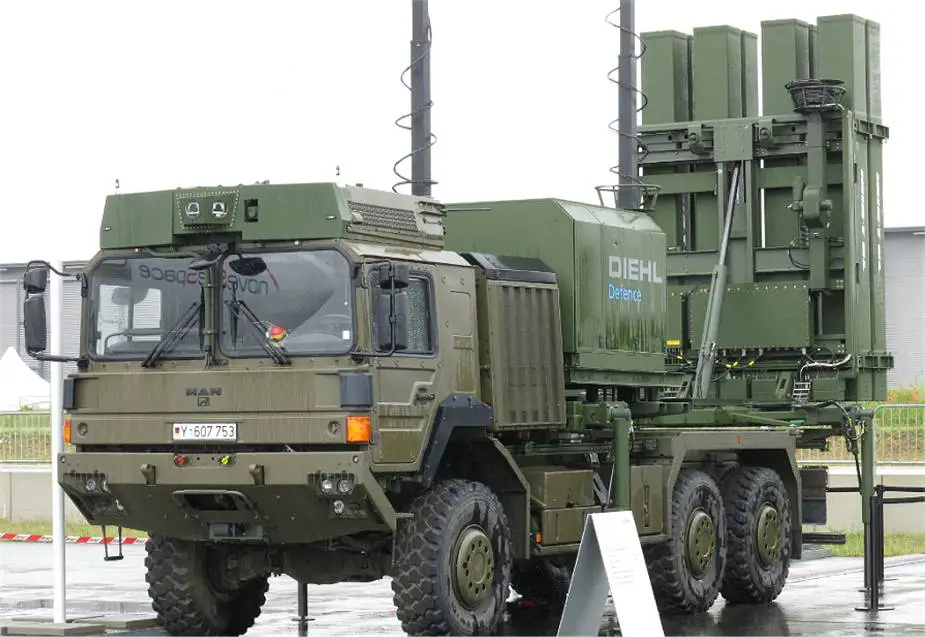Breaking news
Germany plans to invest €900 million to acquire six IRIS-T air defense missile systems.
As reported by the global media outlet, Reuters, on June 13, 2023, Germany is set to boost its air defense capabilities with the procurement of six IRIS-T SLM missile systems. The transaction, valued at an estimated €900 million, is expected to considerably enhance the country's Air Force. The first IRIS-T SLM system will be delivered in 2024, with five additional units to follow by 2027. There are also plans underway to integrate mixed SLS/SLM systems.
Follow Army Recognition on Google News at this link

Launcher unit of IRIS-T air defense missile system. (Picture source Wikimedia)
Under the umbrella of the LVS NNbS program, the German Ministry of Defense is committed to advancing the nation's short-range and very short-range air defense mechanisms. This initiative aims to address current capability gaps in safeguarding ground troops and tactical operation centers, among other assets, from aerial threats of short and very short range.
The LVS NNbS program is anticipated to phase out and upgrade the functionalities of the existing Mantis weapon system and the Ozelot light air defense system. At present, the German armed forces' inventory includes two Mantis systems and two Ozelot platoons.
In a comprehensive revamp of its air defense strategy, Germany plans to assimilate the IRIS-T, Israeli Arrow 3, and American PATRIOT air defense missile systems into its armed forces' arsenal.
The IRIS-T (Infra-Red Imaging System Tail/Thrust Vector-Controlled) is a German-led program to develop a short-range infrared homing air-to-air missile to replace the AIM-9 Sidewinder found in some NATO countries.
The IRIS-T's development started in 1996 and has involved Germany, Greece, Italy, Canada, Norway, and Sweden. The leading company in the development and production of the IRIS-T missile is Diehl Defence, which is a subsidiary of Diehl Stiftung GmbH. Diehl Defence is a German corporate group that is largely involved in the production of defense and security systems.
The company has developed various versions of the IRIS-T, including the IRIS-T SL, the IRIS-T SLS (Short-Range) and IRIS-T SLM (Medium-Range), which have enhanced capabilities to destroy aircraft, helicopters, cruise missiles, air-to-surface missiles, anti-ship missiles, anti-radar rockets and large-calibre rockets. They have a high probability of a killing shot against UAVs and other small manoeuvring threats at very-short and medium-range distances.
The IRIS-T SL (Surface Launched) and IRIS-T SLM (Surface Launched Medium Range) are modified versions of the IRIS-T missile and have been configured to provide ground-based air defense capabilities. They are appreciated for their precision and their effectiveness against a comprehensive range of aerial threats including aircraft, helicopters, drones, and missiles.
One of the defining features of these systems is their extensive engagement envelope. The IRIS-T SL has a range of approximately 25 kilometers and a maximum altitude of around 20 kilometers. The newer IRIS-T SLM, with an enhanced rocket motor, can reach out to even greater distances, but exact figures are not publicly available as of my knowledge cut-off in September 2021.
These systems offer high agility thanks to a high-thrust rocket motor and thrust vectoring, enabling extreme maneuverability and the capability to intercept targets exhibiting unpredictable flight paths.
Their homing head, which uses an imaging infrared sensor, can reliably detect targets, making them resistant to jamming or decoying and enabling effective operation in complex electronic warfare environments.
The IRIS-T SL and SLM can be integrated into network-centric warfare environments, allowing them to share information with and receive commands from other assets on the battlefield, which enhances their situational awareness and effectiveness.
Defense News June 2023


























